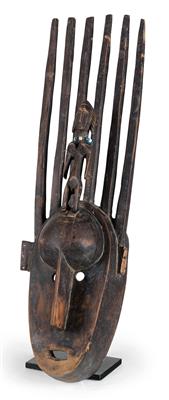Bambara (or Bamana), Mali: a ‘n’tomo mask’ wth six long spikes and a female figure above.
Bambara (or Bamana), Mali: a ‘n’tomo mask’ wth six long spikes and a female figure above.

The Bambara (or Bamana) are workers of the land in the savanna and with more than three million people, the largest ethnic group in Mali. The social organisation of the Bambara is traditionally divided into six age groups, known as ‘dyow’. By means of instruction, examinations and initiations, one advances from one age group into the next. At these initiation festivals, the masks belonging to the respective age groups make their appearance.
The first level in this hierarchy of age groups is called ‘n’tomo’ – and the present mask is a ‘n’tomo mask’. It is made of hard, light-coloured wood and carries six tall, straight spikes on its mask head. That is a sign for a ‘female’ mask. On the hemispheric protruding forehead area of the mask stands a small, very finely carved female figure, called ‘nyeleni’. It has a typical Bambara hairstyle, pierced ears, scarification marks and a necklace of white and blue glass beads. The ‘nyeleni’ (or ‘jonyeleni’) represent the ideal image of a woman.
This perfect ‘n’tomo mask’ is oblong, very deeply crafted and its exterior is of dark brown colour. It displays under the half-round forehead two small, round eyes next to a long, narrow nose and a small, open mouth. Both angular protruding and pierced ears display some insignificant breaks, one old, the other more recent. The charming female figure above the forehead must have once been broken above the feet. A repair is visible (glued area). Otherwise: minor cracks on the half-rounded forehead and on the right cheek of the mask, as well as colour scuffing as a result of age and usage on the chin and nose. And yet with a very good, convincing usage patina on the light-coloured interior of this ‘n’tomo mask’.
Height: c. 69 cm; width: 20 cm. First half of the 20th century. (ME)
Provenance: Austrian private collection.
Lit.: ‘Bamana’ by Jean-Paul Colleyn, ill. 30–34.
Specialist: Erwin Melchardt
 Erwin Melchardt
Erwin Melchardt
+43-1-515 60-465
erwin.melchardt@dorotheum.at
06.04.2017 - 15:00
- Realized price: **
-
EUR 1,500.-
- Starting bid:
-
EUR 800.-
Bambara (or Bamana), Mali: a ‘n’tomo mask’ wth six long spikes and a female figure above.
The Bambara (or Bamana) are workers of the land in the savanna and with more than three million people, the largest ethnic group in Mali. The social organisation of the Bambara is traditionally divided into six age groups, known as ‘dyow’. By means of instruction, examinations and initiations, one advances from one age group into the next. At these initiation festivals, the masks belonging to the respective age groups make their appearance.
The first level in this hierarchy of age groups is called ‘n’tomo’ – and the present mask is a ‘n’tomo mask’. It is made of hard, light-coloured wood and carries six tall, straight spikes on its mask head. That is a sign for a ‘female’ mask. On the hemispheric protruding forehead area of the mask stands a small, very finely carved female figure, called ‘nyeleni’. It has a typical Bambara hairstyle, pierced ears, scarification marks and a necklace of white and blue glass beads. The ‘nyeleni’ (or ‘jonyeleni’) represent the ideal image of a woman.
This perfect ‘n’tomo mask’ is oblong, very deeply crafted and its exterior is of dark brown colour. It displays under the half-round forehead two small, round eyes next to a long, narrow nose and a small, open mouth. Both angular protruding and pierced ears display some insignificant breaks, one old, the other more recent. The charming female figure above the forehead must have once been broken above the feet. A repair is visible (glued area). Otherwise: minor cracks on the half-rounded forehead and on the right cheek of the mask, as well as colour scuffing as a result of age and usage on the chin and nose. And yet with a very good, convincing usage patina on the light-coloured interior of this ‘n’tomo mask’.
Height: c. 69 cm; width: 20 cm. First half of the 20th century. (ME)
Provenance: Austrian private collection.
Lit.: ‘Bamana’ by Jean-Paul Colleyn, ill. 30–34.
Specialist: Erwin Melchardt
 Erwin Melchardt
Erwin Melchardt
+43-1-515 60-465
erwin.melchardt@dorotheum.at
|
Buyers hotline
Mon.-Fri.: 10.00am - 5.00pm
kundendienst@dorotheum.at +43 1 515 60 200 |
| Auction: | Tribal Art |
| Auction type: | Saleroom auction |
| Date: | 06.04.2017 - 15:00 |
| Location: | Vienna | Palais Dorotheum |
| Exhibition: | 01.04. - 06.04.2017 |
** Purchase price incl. buyer's premium and VAT
It is not possible to turn in online buying orders anymore. The auction is in preparation or has been executed already.
